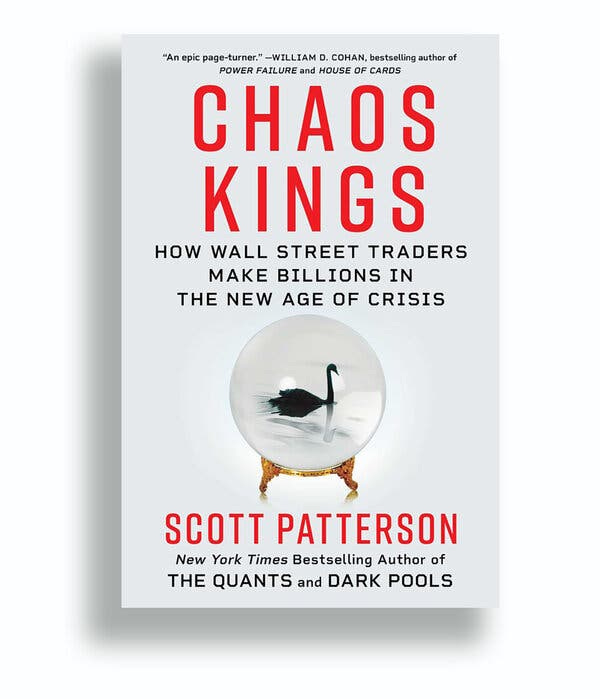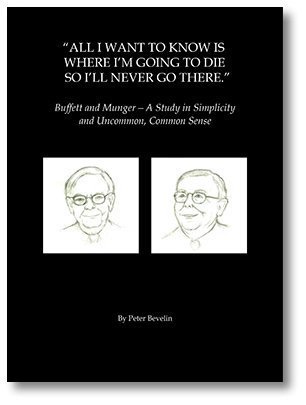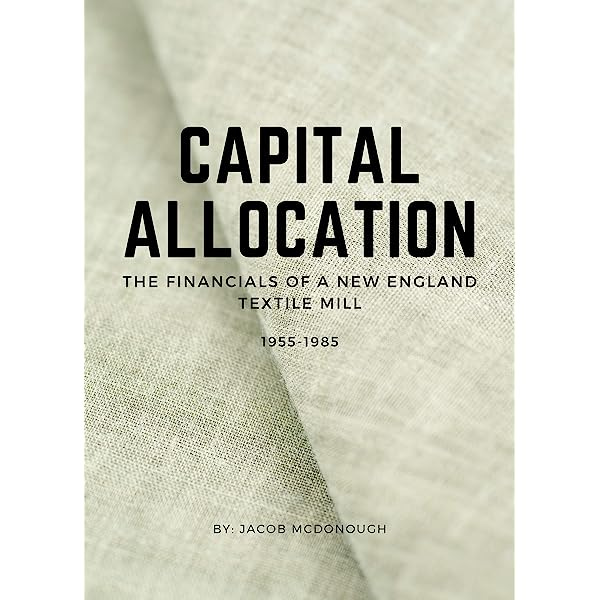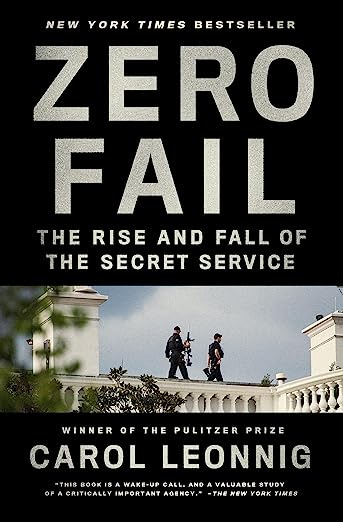This Month We Read:
Chaos Kings: How Wall Street Traders Make Billions in the New Age of Crisis by Scott Patterson
Safe Haven: Investing for Financial Storms by Mark Spitznagel
Boyd: The Fighter Pilot Who Changed the Art of War by Robert Coram
All I Want To Know Is Where I’m Going to Die So I’ll Never Go There by Peter Bevelin
Capital Allocation: The Financials of a New England Textile Mill by Jacob McDonough
Fire Weather: A True Story from a Hotter World by John Vaillant
Zero Fail: The Rise and Fall of the Secret Service by by Carol Leonnig
Chaos Kings: How Wall Street Traders Make Billions in the New Age of Crisis by Scott Patterson
As much as I love reading about value-oriented investors that follow a similar business-minded approach to investing, I equally enjoy reading about successful investors that have a vastly different strategy than Eagle Point. This helps broaden my perspective and there’s almost always something to takeaway from these seemingly unrelated approaches. Chaos Kings (and Safe Haven, more on that below) fits squarely within the latter group.
In his recently released book Patterson details a handful of investors who seek to profit from market dislocations. The most notable, and consistently successful, examples are Nassim Taleb and Mark Spitznagel. Taleb happens to be one of my favorite authors and personal heroes (he wrote The Black Swan, Antifragile, Skin in the Game, and others). Bill Ackman is also featured thanks to has handful of well-timed macro hedges.
Most of these investors employ a “tail risk hedging” approach whereby they aim to buy deeply out-of-the-money put options on index funds that almost always expire worthless, but in the rare event of a market crash the options become insanely valuable and can return 1,000% or more over the course of a few months. Investors put a few percent of their capital into these strategies (and the rest into stocks) to hedge the occasional market crashes. Usually, this “insurance” ends up costing more than it’s worth, and almost always people would be better off in an index fund with no hedging. In rare cases, such as Spitznagel’s Universa fund, the blended strategy (3% tail hedges, 97% long S&P 500) has produced annual net returns about 3% in excess of the S&P. They achieve returns very differently than how a long-only approach achieves them, but there’s nothing wrong with that and the effect has been powerful.
What’s interesting is now that I’ve stated what Spitznagel does is vastly different than what we do, I’ll go ahead and contradict myself. Patterson writes about Spitznagel’s wildly successful approach:
“The Value approach is a kissing cousin to what I do” Spitznagel told me. “I’m buying stuff people think is garbage”…to be sure, it isn’t easy. Value investing is by definition contrarian - it works by going against the crowd, and many investors find that very hard to do.
Value looks different to different people, and that’s great. To Sptiznagel and Taleb it looks like buying undervalued, deeply out-of-the-money, put options on the S&P 500 and waiting for a crash. To us, it looks like buying simple, predictable, profitable businesses facing short-term uncertainty but long term prosperity. At it’s heart I think value investing is simply buying assets (whether it be a business, a piece of real estate, or an option contract) with the downside well understood and controlled while enjoying a substantially asymmetric potential upside.
The good news is, both approaches work and value can be adapted to whatever suites someone’s skillset as long as the principles are applied diligently.
Dan
Safe Haven: Investing for Financial Storms by Mark Spitznagel
Safe Haven is a continuation of what I wrote about above in Chaos Kings. Safe Haven is a detailed look at why Spitznagel has elected to pursue his tail risk hedging approach. He leans fairly heavily on math and some of the technical aspects of why he invests the way he does, but I found the book fascinating (and timely given it was written only a few years ago).
Spitznagel coined the “Safe Haven” concept as an investment strategy that can take different shapes. He explains:
“Whatever forms they may take, it is their function that makes safe havens what they are: They preserve and protect your capital. They are a shelter from financial storms.”
The main argument Spitznagel makes throughout the book is that Safe Haven investing should be effective but also, and more importantly, cost effective. For example, he shows that while owning a large percentage of U.S. treasuries can loosely qualify as an effective Safe Haven - they usually are resilient during market crashes (but not always - see 2022) - they are far from cost effective. Investors who own a high percentage of treasuries are exceedingly likely to earn worse overall returns than those that just own a diversified basket of stocks. If employing a Safe Haven strategy doesn’t raise your overall compound annual return, and resulting wealth at the end of the day, then what’s the point in pursuing the strategy in the first place? I couldn’t agree more.
He also does a great job of really showing the power of avoiding major permanent losses. It’s possible to have a strategy that produces a lower arithmetic average return (or expected value) but a higher geometric (i.e. compound) return, which is what counts. This is because of the devastating impact of huge drawdowns (we’re talking 50%+) have on compounding, particularly when losses are crystalized by selling at the worst time, which so many investors often tend to do during crises. Compounding doesn’t care what your average return is, because it’s a multiplicative process. If you mix in a major negative return - or god forbid a zero - to your overall portfolio, it doesn’t matter what the returns were in between, your capital is going to be seriously impaired or wiped out. Hence the idea of following the Safe Haven approach.
Just like in Chaos Kings, a Safe Haven can look different to different people. Spitznagel debunks most of the typical Safe Haven approaches like owning bonds, most hedge funds, and gold (over most periods). Virtually all of these classic approaches lead to lower overall returns. But that needn’t always be the case.
To our readers it’s probably pretty clear what Safe Haven investing means to us - high quality, cash generative businesses with largely uncorrelated, durable cash flows and below average purchase prices, among other things.
Setting aside the technical aspects of Universa’s approach - I doubt most people can figure out how to cost effectively buy out-of-the-money options while selling-near-the-money options to lower the overall cost AND consistently monetize these options at the right time when the market tanks all while tactically rolling the options over each month to avoid too much time decay - the overall concept is undoubtedly a valuable one for investors, regardless of their approach.
Dan
Boyd: The Fighter Pilot Who Changed the Art of War by Robert Coram
After reading Skunk Works: A Personal Memoir of My Years of Lockheed by Ben Rich in February I was eager to continue learning about the defense contractors. Boyd came highly recommended and I was not disappointed. The book as a slow build, so if you start it be sure to stick with it as it keeps getting better right up to the end.
Boyd was one of America’s best fighter pilots. He eventually became a teacher at Fighter Weapons School (now called Weapon’s School, the Air Force’s answer to the Navy’s Top Gun) and then moved on to the Pentagon where he helped design new fighter aircraft like the F-15. Students called him “Forty second Boyd” at Fighter Weapons School because he’d bet anyone he could win a dogfight in under 40 seconds… and never had to pay out.
Boyd was a brilliant strategist and extraordinarily hard worker, regularly pulling all-nighters on projects he wasn’t officially put on. But he was an aggressive fighter pilot through and through and never dealt with authority well. His battles with the Air Force’s bureaucracy were as legendary as his battles with MiGs.
Boyd’s legacy is the OODA Loop which is a decision-making framework for fighter pilots (but universally applicable) that is best described as a modern day interpretation and distillation of Sun Tzu. The OODA Loop is simple in theory but requires nuance to apply it correctly. OODA stands for Observe, Orient, Decide, and Act.
At it’s core, the OODA Loop is about making decisions faster than your enemy and using techniques to throw them off balance before ever actually engaging in battle. It encourages choices which lead to lots of future options. When you have lots of options at your disposal you can be opportunistic. It’s also about asymmetry: small risks that can produce huge payoffs. Boyd makes an important point we see time and time again in investment — that uncertainty does not necessarily equal risk. For example, a fair coin toss that pays you $2 for a heads and costs you $1 for a tails has an uncertain payoff (at least in the short term) but it is not risky if you manage your bank roll properly. The opposite of Boyd’s OODA Loop philosophy is engaging in a war of attrition. Farnam Street has a good primer on Boyd’s OODA Loop for those who want to learn more.
Below are some quotes which I think represent Boyd’s personality, outlook, and philosophy best. I’d highly recommend this book for anyone interested in how the defense sector works with the pentagon or about strategic thinking, in war and beyond.
“judge people by what they do and not what they say they will do.”
“And you’re going to have to make a decision about which direction you want to go.
He raised his hand and pointed. “If you go that way you can be somebody. You will have to make compromises and you will have to turn your back on your friends. But you will be a member of the club and you will get promoted and you will get good assignments.”
Then Boyd raised his other hand and pointed another direction.
"Or you can go that way and you can do something — something for your country and for your Air Force and for yourself. If you decide you want to do something, you may not get promoted and you may not get the good assignments and you certainly will not be a favorite of your superiors. But you won’t have to compromise yourself. You will be true to your friends and to yourself. And your work might make a difference. To be somebody or to do something. In life there is often a roll call. That’s when you will have to make a decision. To be or to do? Which way will you go?”
“Thinking about operating at a quicker tempo - not just moving faster - than the adversary was a new concept in waging war. Generating a rapidly changing environment - that is, engaging in activity that is quick it is disorienting and appears uncertain or ambiguous to the enemy - inhibits the adversary's ability to adapt and causes confusion and disorder that, in turn, causes an adversary to overreact or underreact. Boyd closed the briefing by saying the message is that whoever can handle the quickest rate of change is the one who survives.”
“Understanding the OODA loop enables a commander to compress time - that is, the time between observing a situation and taking an action. A commander can use the temporal discrepancy (a form of fast transient) to select the least-expected action rather than what is predicted to be the most effective action. The enemy can also figure out what might be the most effective. To take the least-expected action disorients the enemy. It causes him to pause, wonder, to question.”
Matt
All I Want To Know Is Where I’m Going to Die So I’ll Never Go There by Peter Bevelin
All I Want To Know Is Where I’m Going to Die So I’ll Never Go There pairs well with the other Bevelin book, Seeking Wisdom, that I wrote about in May’s Reading Roundup. Bevelin stages the book as a conversation between Buffet, Munger, a wise “librarian” (who is essentially Bevelin) and a wisdom-seeking screw-up who wants to learn how to behave more rationally. The book is entirely comprised of quotes from Buffet and Munger from different points in time and put into context as if it were a conversation, which is pretty entertaining.
While there isn’t anything earth shattering for anyone that’s already read a ton of Buffet and Munger, it never hurts to reread many of the classic quotes and pieces of advice. My guess is if you read the book five times each time a different key lesson would sink in; just like listening to old Berkshire meetings many times over.
Here are a few of my favorite quotes from this go-round.
Buffet on what makes a great investment opportunity:
“A great investment opportunity occurs when a marvelous business encounters a one-time huge, but solvable, problem as was the case many years back at both American Express and GEICO”.
This is such a simple quote but an incredibly powerful idea. Many of our best (and favorite) investments have historically followed this pattern. Wait for a great business to run into a short term headwind, accept that the future will again one day resemble the past when the business wasn’t experiencing temporary headwinds, and wait for the business to muddle through the current challenge. It’s easy to say, but often times harder than you expect to pull the trigger when the “huge, but solvable” problems come along, which is why investors need to be really comfortable with businesses going through such periods before committing capital to them.
Here’s Munger on how to leave others in the dust:
“I would argue that what Berkshire has done has mostly been using trivial knowledge…if you absorb the important basic knowledge…and you absorb all the big basic points across a broad range of disciplines, one day you’ll walk down the street and you’ll find that you’re one of the very most competent members of your generation, and that many people who were quicker mentally and worked harder are in your dust”.
It reminds me of the Buffett quote that goes “you don’t need to do extraordinary things to get extraordinary results”. The few investors that can relentlessly apply a rational approach for a long period of time will look back and find most others left in their dust. It doesn’t take a complicated process or mastery of higher mathematics; it takes willingness to keep learning, tremendous discipline, and time.
There are, quite literally, hundreds of great quotes throughout the book, so I’d recommend everyone read it at least once.
Dan
Capital Allocation: The Financials of a New England Textile Mill by Jacob McDonough
Capital Allocation is an interesting in-depth look at the financial details surrounding Berkshire Hathaway during it’s earliest days, starting when Buffet took control in the mid-’60s. A lot has been written about the qualitative “stories” around Buffet’s early major investments, but Jacob McDonough dissects the detailed SEC filings at the time of purchase.
This really places readers in Buffet’s “shoes” as the events were unfolding. I found this an interesting and helpful exercise, even if the types of businesses he was buying, like Diversified Retailing, Blue Chip Stamps, or Berkshire Hathaway (the textile mill) are not the types of businesses I’d be interested in buying in today’s world.
Some of my favorite takeaways from the book were Buffet’s consistent penchant for using leverage to his advantage as well as marveling at how much cash he was able to take out of the businesses in relation to his purchase price over the first few years.
Anyone that’s listened to Buffet extensively knows he has a penchant for advising against using leverage given its destructive power. While that’s true, the leverage Buffet advises against is short-term callable debt or heavy use of margin that can turn an otherwise sound investment into a forced liquidation. This was generally not the leverage Buffet employed (though some investments, like Diversified, were financed with traditional debt, far in excess of what he would advise today).
Instead, time and again Buffet has gotten his hands on low-cost non-amortizing leverage. Blue Chip Stamps’ customers paid up front for stamps that could be redeemed at a later date (and often never were), Illinois National Bank enjoyed low-cost and high-quality deposits, and of course his myriad of early insurance investments (including GEICO) all generated significant float. In each case Buffet was able to use cash that technically didn’t belong to Berkshire (i.e. it was a liability) but it was unable or unlikely to be called any time soon, so Buffet could allocate it to other high returning investments.
People often think of Buffet as a stodgy, boring anti-leverage investor. This is far from true, as Berkshire has used significant leverage over the years. It’s just been smart, low-risk leverage that minimized any chance of permanent damage to the business. The result of all of these early deals was the beginnings of a capital efficient form of compounding, and we all know how that turned out for the early Berkshire investors.
Dan
Fire Weather: A True Story from a Hotter World by John Vaillant
Fire Weather tells the story of the 2016 Fort McMurray fire which nearly wiped Ft. McMurray, the heart of Alberta’s oil sands industry, off the map. The incident is referred to as Canada’s Katrina, but is not nearly as widely known. As I was halfway through this book smoke from Canadian wildfires descended on Chicago for several days. It was so smoky that it smelled like a campfire, which made reading this even more eerie.
Vaillant divides the book into three sections. The first is an overview of Canada’s oil sands industry. I found this fascinating and I think most investors will too. The second section tells the story of the fire and the fight to save the city. This read like a page-turning action novel. Amazingly, even though most of the city was burned to the ground and evacuation orders were given at the last possible second, not a single fatality was reported. The third section provides an overview of the science behind global warming. The author clearly finds it ironic that a city built on oil and carbon emissions was one of the first to be destroyed by rising temperatures. I found this last section dry and boring, almost like an admonishment for CO2 pollution. While I don’t disagree with Vaillant’s conclusions about the dangers of global warming, the third section didn’t seem to fit the style and narrative of the book to that point.
Nevertheless, I am a huge fan of author John Vaillant and recommend everyone read his book The Tiger: A True Story of Vengeance and Survival.
Matt
Zero Fail: The Rise and Fall of the Secret Service by by Carol Leonnig
Zero Fail is the story of the Secret Service, beginning with JFK’s assassination through to the early Trump years. The book dutifully covers the Secret Service’s most “exciting” moments, including the Kennedy assassination, Squeaky Fromme’s attempt on Gerald Ford, and John Hinckley’s shooting of Ronald Reagan. However, most of the book is about the Service’s back-office politics and bureaucracy, increasing politicization, and the “bad boy” behavior of certain agents.
The author believes that the Secret Service has gone downhill and that it does not have the right management, budget, or support to succeed in its “zero-fail” mission. Unfortunately, things rarely change before something terrible happens.
If there is a theme and take-away from this book it is the importance of culture in any organization. The author explains that morale at the Secret Service is low because the agency transfers agents around the world every few years with little regard for their preferences. Transfers and promotions operate like a old boys network, favoring a few, and not because of merit. The author argues that there are relatively straightforward fixes to issues like these that would improve morale and allow the Service to recruit from a broader pool of more qualified applicants.
I found the book interesting but long at 500+ pages. I’d only recommend it for those were a serious interest in the Secret Service.
Matt
The Best of the Rest
WSJ: Interest-Only Loans Helped Commercial Property Boom. Now They’re Coming Due. “Xiaojing Li, managing director at data company CoStar’s risk analytics team, estimates that as much as 83% of outstanding securitized office loans won’t be able to refinance if interest rates stay at current levels.
WSJ: Eight Megacap Stocks Make for a Funny Sort of Bull Market. Taken together, these tailwinds have pushed the biggest stocks as measured by the Russell Top 50 Mega Cap index to beat the Russell 2000 index of smaller companies by more than 20 percentage points this year, better than any five-month period from the creation of the measure in 2002 up to the pandemic.
WSJ: Hotel Owners Start to Write Off San Francisco as Business Nosedeives. “Hotel owners in New York and Los Angeles are filling nearly as many rooms this year as they did in 2019, according to hotel-data firm STR. Their revenue per available room exceeds what it was before the pandemic. But in San Francisco, hotels are still struggling badly in both occupancy and room rates compared with before the pandemic. Revenue per available room was nearly 23% lower in April compared with the same month in 2019.”
Byrne Hobart: Coins as Tangible History. “In good times, it’s easy to round the risk of chaos down to zero, but any student of financial history can tell you that a risk that everyone rounds to zero eventually has a probability of 1.”
Investors Guide: Interview With Joel Greenblatt. “What tends to happen, on a systematic basis anyway, is people tend to over-avoid those companies that have the obvious, immediate problems because they want to make money now. And what would you buy something that clearly has a problem right in front of it in the next year or two? People tend to over discount that. There’s a lot of ways to be a value investor. You can buy things after they’ve fallen or you can buy things that are anticipated that the next year or two might be a little tougher than normal.”
Bruce Flatt at the Forbes Iconoclast Summit. “The most under-appreciated thing in the world, most of the time, is the long-term compounding of wealth. Great wealth is created by compounding. So stay invested. Buy great things with great people and great companies.”
Chris Mayer: The Wisdom of K. “It is ironic isn’t it? Investing is a pursuit that rewards seeming inactivity. Tons of research backs this up. I’ve never seen a study that showed people who turn over their portfolios a lot do better than those that sit on their hands. And yet so many keep trying. Thinking, somehow, they are going to be the one to buck the trend, to make the great moves in avoiding the next crash and trading their way to glory.
I have a friend who told me he took his whole 401K to cash before the debt ceiling crisis. The conversation went like this:
Me: You know, market timing doesn’t work. You’d be better off just leaving that money alone and not thinking about it.
Him: It’s not market timing. I’m just waiting for this crisis to blow over. Then I’ll go back in.
I am not making this up. Everyone thinks they are special.”
One-Percenters Keep Shopping at the Dollar Store. “That Mercedes in the dollar-store parking lot isn’t an illusion. High-earners joined the rest of the country in flooding discount retailers such as Dollar General, Aldi grocery store and Five Below as prices for food and staples rose. Now, with inflation at half its peak, they aren’t letting up.”
John Huber: Attributes of a Great Business and a Simple Investment Checklist. “The longer your time horizon, the more that capital allocation matters to the value of your stock.”
Bill Ackman: Pershing Square’s Q3 2008 Letter. “Thirty years ago, no one could have foreseen the huge expansion of the Vietnam War, wage and price controls, two oil shocks, the resignation of a president, the dissolution of the Soviet Union, a one-day drop in the Dow of 508 points, or treasury bill yields fluctuating between 2.8% and 17.4%. But, surprise - none of these blockbuster events made the slightest dent in Ben Graham's investment principles. Nor did they render unsound the negotiated purchases of fine businesses at sensible prices. Imagine the cost to us, then, if we had let a fear of unknowns cause us to defer or alter the deployment of capital. Indeed, we have usually made our best purchases when apprehensions about some macro event were at a peak. Fear is the foe of the faddist, but the friend of the fundamentalist.”
WSJ: Big Oil Mulls a Slippery Future. OPEC predicts oil demand will increase 10% by 2045, which is as far out as they project. However, “the share prices of Shell, BP, Exxon Mobil and Chevron all imply that the companies’ profits will permanently decline from today’s levels.”
Bloomberg: Oil is Hard to Quit, Even in Norway Where Electric Cars Rule the Road. “Gasoline use has fallen by 37% since 2013… Diesel consumption in Norway is just 10% below its 2015 peak and has yet to show a consistent downtrend, with demand rebounding since 2020.”
Greenlight Capital: Free Peanut Butter (presentation at Ira Sohn 2023). “My belief is that shifting trillions of dollars from active management to passive management meant shifting money from strategies that generally at least consider valuation to those that don’t. The result is that there has been a net selling of undervalued stocks, which active managers tend to own, and net buying of overvalued stocks, which are by definition overweighted in indices.”
Brooklyn Investor: The Next Chipotle, The Next Berkshire.” But one thing that strikes me from looking at this CMG table is that it is OK to wait for profitability before investing. CMG didn’t turn profitable until 2004, and they had their IPO in January 2006. Even if you didn’t get the IPO price and you bought in at the end of 2006, you would have bought in at $57 and would be sitting on a nice return.”
Memo from Howard Marks: Taking the Temperature. “Engage in pattern recognition. Study market history in order to better understand the implications of today’s events. Ironically, when viewed over the long term, investor psychology and thus market cycles - which seem flighty and unpredictable - fluctuate in ways that approach dependability”
Do you have a “stranded” 401k from a past job that is neglected and unmanaged? These accounts are often an excellent fit for Eagle Point Capital’s long-term investment approach. If you would like to invest with Eagle Point Capital or connect with us, please email info@eaglepointcap.com.
Disclosure: The author, Eagle Point Capital, or their affiliates may own the securities discussed. This blog is for informational purposes only. Nothing should be construed as investment advice. Please read our Terms and Conditions for further details.












I look forward to these posts every month, thank you so much for putting them together.